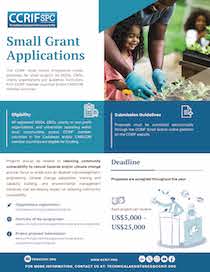Grand Cayman, 15 March, 2010 – Since 2007, sixteen Caribbean governments have included parametric insurance policies against hurricanes and earthquakes from the Caribbean Catastrophe Risk Insurance Facility (CCRIF) as part of their countries’ disaster risk management portfolios. In light of the recent earthquakes in Haiti and Chile, many of these countries are re-examining their preparedness for natural catastrophes, including their levels of coverage under CCRIF. The recent payout to Haiti by CCRIF of US$7.75 Million, or 20 times that country’s premium, following the devastating earthquake of 12 January demonstrated the speed at which CCRIF is able to make funds available to governments after a disaster. However, the small size of that payment relative to the levels of devastation highlights the need for increased levels of coverage that would result in larger payouts which can do even more to stabilise government services and provide a springboard to more rapid and comprehensive recovery.
Over the last two and a half years, CCRIF has achieved global prominence as a model for innovative, ex-ante disaster risk transfer. Such mechanisms can and should be included in disaster risk management strategies for countries vulnerable to hurricanes, earthquakes and other natural catastrophe events, and can be a critical component of a country’s climate change adaptation framework. Prior to its response in Haiti, CCRIF had paid out almost US$1 Million to the Dominican and St Lucian governments after the 29 November 2007 earthquake in the eastern Caribbean and about US$6.3 Million to the Turks & Caicos Islands after Hurricane Ike made a direct hit on Grand Turk in September 2008.
Today, Caribbean countries are faced with decisions regarding the level of their CCRIF coverage, which is renewed each year on 1 June, against the backdrop of reduced fiscal space emanating from the continued legacy of the global economic crisis.
In light of the above, the CCRIF Board and operations team have been engaged in a number of activities aimed at finding solutions that would enable its members to continue to pursue diversified and dynamic disaster risk management policies. One such activity has been meeting with country clients and key stakeholders towards ascertaining members’ needs and then making the case to international donor partners for the need for assistance in stepping up the level of coverage that countries are able to garner from CCRIF.
According to Dr Simon Young, CEO of Caribbean Risk Managers, the Facility Supervisor of CCRIF: “We believe that there is a very strong case to be made to the international development community to assist CCRIF’s member countries (and potential new members) in upscaling the role that risk transfer plays in post-disaster financing. In so doing, CCRIF would become an even stronger example of a successful, innovative public-private partnership addressing a core barrier to sustainable development, particularly in the face of climate change.” In fact, at the CARICOM Heads of Government meeting in Dominica, World Bank President Robert Zoellick presented the strong interest of the Bank in developing “a strategy [for the region] that focuses on growth … good fiscal management, effective use of debt, maybe looking at some of the issues of what else one can do to build insurance for some of the natural calamities that tend to create a spike in debt.”
About CCRIF: CCRIF is a risk pooling facility, owned, operated and registered in the Caribbean for Caribbean governments. It is designed to limit the financial impact of catastrophic hurricanes and earthquakes to Caribbean governments by quickly providing short term liquidity when a policy is triggered. It is the world’s first and, to date, only regional fund utilising parametric insurance, giving Caribbean governments the unique opportunity to purchase earthquake and hurricane catastrophe coverage with lowest-possible pricing. CCRIF represents a paradigm shift in the way governments treat risk, with Caribbean governments leading the way in pre-disaster planning. CCRIF was developed through funding from the Japanese Government, and was capitalised through contributions to a multi-donor Trust Fund by the Government of Canada, the European Union, the World Bank, the governments of the UK and France, the Caribbean Development Bank and the governments of Ireland and Bermuda, as well as through membership fees paid by participating governments.
Sixteen governments are currently members of CCRIF: Anguilla, Antigua & Barbuda, Bahamas, Barbados, Belize, Bermuda, Cayman Islands, Dominica, Grenada, Haiti, Jamaica, St. Kitts & Nevis, St. Lucia, St. Vincent & the Grenadines, Trinidad & Tobago and the Turks & Caicos Islands.
For more information, contact Simon Young at syoung@caribrm.com or CCRIF at pr@ccrif.org.





